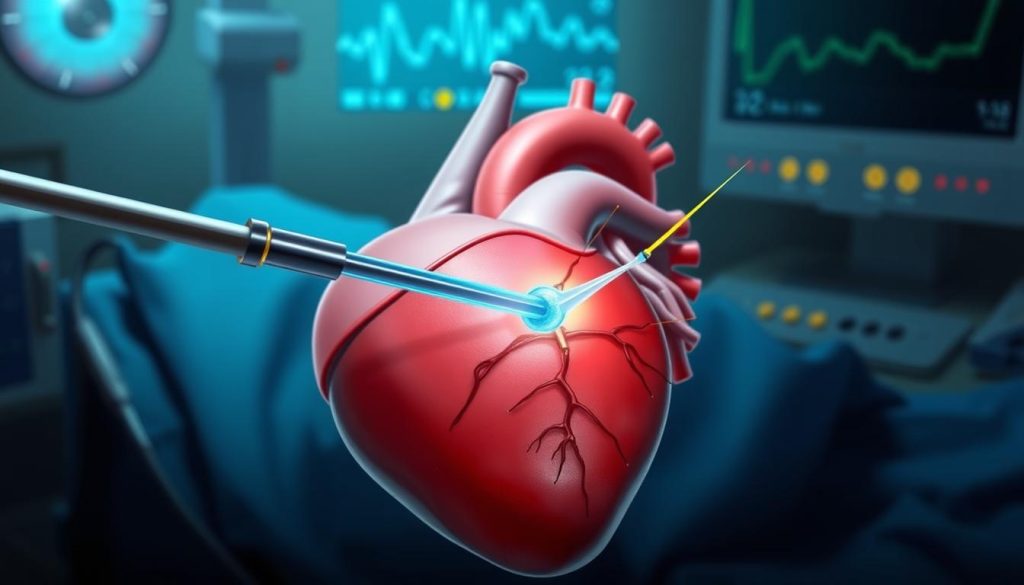Atrial fibrillation is a heart rhythm disorder that affects millions worldwide. For those who don’t respond to medication, maze surgery is a solution. This cardiac procedure aims to restore normal heart rhythm and improve quality of life.
Maze surgery for atrial fibrillation makes precise incisions in the heart’s upper chambers. These incisions form a maze-like pattern. This blocks the abnormal electrical signals that cause irregular heartbeats.
By redirecting these signals, the procedure helps the heart maintain a steady rhythm. This article will explore maze surgery, its benefits, and what patients can expect. We’ll cover the procedure, recovery, and long-term outcomes.
Whether you’re considering atrial fibrillation surgery or just want to learn more, this guide is for you. It provides valuable insights into this important cardiac treatment option.
What Is Maze Surgery and Its Role in Treating Atrial Fibrillation
Maze surgery is a new way to treat atrial fibrillation (AFib). It aims to fix the heart’s rhythm by making scar tissue in the upper chambers. This creates a maze-like pattern.
Definition and Basic Principles
The surgery makes precise cuts or ablations in the atrial walls. These cuts block bad electrical signals that cause AFib. They guide the heart’s electrical impulses to keep a regular beat.
Historical Development of the Procedure
Dr. James Cox introduced the Cox maze procedure in 1987. It was a big step in treating AFib. The method has evolved, becoming less invasive and using different energy sources.
Key Benefits for AFib Patients
Maze surgery has many benefits for AFib patients:
- High success rates in restoring normal sinus rhythm
- Reduced need for long-term medication
- Decreased risk of stroke
- Improved quality of life
As a cutting-edge treatment, maze surgery offers hope to those who haven’t found relief elsewhere. It tackles the heart’s rhythm problems directly, making it a key tool for cardiac surgeons.
Common Symptoms and Indicators for Maze Surgery
Atrial fibrillation surgery is considered when symptoms last a long time and affect daily life. It’s important to know these signs early for effective treatment.
- Irregular heartbeats or palpitations
- Shortness of breath, specially during physical activity
- Fatigue or weakness
- Chest pain or discomfort
- Dizziness or lightheadedness
These symptoms can be different for everyone. Some people might have them now and then, while others feel them all the time. If medicines don’t help enough, doctors might suggest surgery.
“Maze surgery offers hope to patients who’ve exhausted other treatment options and continue to struggle with the debilitating effects of atrial fibrillation.”
Tests are key to see if someone needs maze surgery. These tests include:
| Diagnostic Test | Purpose |
|---|---|
| Electrocardiogram (ECG) | Records heart’s electrical activity |
| Echocardiogram | Assesses heart structure and function |
| Holter monitor | Tracks heart rhythm over 24-48 hours |
| Stress test | Evaluates heart performance during exercise |
Doctors look at how long atrial fibrillation lasts, past treatments, and overall health. They use this information to decide if maze surgery is right.
The Evolution of Cox-Maze Procedure: From Traditional to Modern Approaches
The Cox maze procedure has seen big changes over the years. It’s now more effective and less invasive for treating atrial fibrillation.
Original Cox-Maze Surgery
Dr. James Cox introduced the Cox maze procedure in 1987. It was a complex surgery that made precise cuts in the atrial walls. These cuts formed a maze pattern to block abnormal electrical signals and fix the heart’s rhythm.
Contemporary Modifications
Today’s Cox maze procedure is simpler than the original. Surgeons use new energy sources to make lesions instead of cuts. These include:
- Radiofrequency energy
- Cryotherapy
- Microwave energy
- High-intensity focused ultrasound
Technological Advancements
New technologies have changed the Cox maze procedure. Now, there are minimally invasive surgeries like thoracoscopic and robotic-assisted ones. These have cut down recovery times and improved results. They make the surgery more available to people with atrial fibrillation.
| Aspect | Traditional Cox-Maze | Modern Cox-Maze |
|---|---|---|
| Incision Type | Surgical cuts | Energy-based lesions |
| Invasiveness | Highly invasive | Minimally invasive options |
| Recovery Time | Longer | Shorter |
| Technological Support | Limited | Advanced imaging and mapping |
How Maze Surgery Works to Restore Normal Heart Rhythm
Maze surgery is a cutting-edge electrophysiology procedure for treating atrial fibrillation. It aims to fix the heart’s rhythm by making scar tissue in the upper chambers.
During the surgery, surgeons make precise cuts in the atria. These cuts form a maze pattern, which is why it’s called maze surgery. As the cuts heal, they create scar tissue that stops irregular electrical signals.
The scar tissue acts as a barrier, forcing electrical impulses to follow a specific path. This new path helps the heart’s electrical activity follow a normal, healthy pattern. So, the heart can beat regularly again.
- Incisions create a maze pattern in the atria
- Scar tissue blocks irregular electrical signals
- New pathway guides normal heart rhythm
Maze surgery can be done alone or with other heart surgeries. Its success depends on careful planning and precise execution. Surgeons use advanced imaging to map the heart’s electrical activity and plan the best incision pattern for each patient.
“Maze surgery has revolutionized atrial fibrillation treatment, giving hope to patients who haven’t found relief with other therapies.”
Maze surgery tackles the heart’s rhythm problem at its source. It offers a lasting solution for many patients. It not only improves heart rhythm but also lowers stroke risk and boosts quality of life.
Comparing Maze Surgery with Other Atrial Fibrillation Treatments
Patients with atrial fibrillation have several treatment options. Maze surgery, medical management, and catheter ablation each have their own benefits and drawbacks. Let’s look at these treatments to see which might be right for you.
Medical Management Options
Many AFib patients start with medication. They take antiarrhythmic drugs and blood thinners to control symptoms and lower stroke risk. These drugs are less invasive but can have side effects and don’t cure the condition.
Catheter Ablation Differences
Catheter ablation is a less invasive procedure for atrial fibrillation. It uses heat or cold to create scar tissue, stopping irregular electrical signals. This method is less invasive than maze surgery but might need multiple treatments.
Long-term Effectiveness Rates
Maze surgery often has higher long-term success rates. Studies show it can keep the heart in normal rhythm in up to 90% of patients after five years. Catheter ablation success rates are lower, usually between 50% to 70% after one procedure.
| Treatment | 5-Year Success Rate | Invasiveness |
|---|---|---|
| Maze Surgery | 85-90% | High |
| Catheter Ablation | 50-70% | Moderate |
| Medical Management | 30-40% | Low |
Choosing between atrial fibrillation surgery options depends on several factors. These include age, overall health, and AFib severity. Talk to your doctor to find the best treatment for your heart health journey.
Preparing for Your Maze Surgery: Essential Steps
Getting ready for maze surgery needs careful planning. Your journey to treat atrial fibrillation through this procedure involves several key steps. Let’s explore what you need to do before your atrial fibrillation surgery.
First, your doctor will schedule preoperative tests. These may include blood work, chest X-rays, and an electrocardiogram. These tests help ensure you’re fit for maze surgery and allow your medical team to plan your care.
Next, you’ll need to adjust your medications. Some drugs, like blood thinners, may need to be stopped before the procedure. Your doctor will provide specific instructions on which medications to continue or pause.
Lifestyle changes are key in the weeks leading up to your maze surgery. Quitting smoking, if applicable, is essential. Eating a heart-healthy diet and staying physically active within your doctor’s guidelines can also improve your surgery outcomes.
“Patient education is a cornerstone of successful maze surgery preparation. Understanding the procedure helps reduce anxiety and promotes faster recovery.”
In the days before your atrial fibrillation surgery, you’ll receive detailed instructions. These often include:
- Fasting guidelines
- Shower instructions using special soap
- What to bring to the hospital
- Arranging for post-surgery care and transportation
| Time Before Surgery | Preparation Step |
|---|---|
| 4-6 weeks | Complete preoperative tests |
| 2-4 weeks | Begin medication adjustments |
| 1-2 weeks | Attend pre-surgery education session |
| 24-48 hours | Start fasting and special cleaning routines |
By following these steps, you’ll be well-prepared for your maze surgery. This sets the stage for a successful procedure and recovery.
The Surgical Process and Technical Aspects
Maze surgery is a detailed electrophysiology procedure that needs great skill. It aims to treat atrial fibrillation by making a maze of scar tissue in the heart.
Anesthesia and Monitoring
Before starting maze surgery, patients get general anesthesia. Doctors watch vital signs closely with advanced tools. They check heart rate, blood pressure, and oxygen levels.
Surgical Techniques
Surgeons use different methods in maze surgery. The old way involves making cuts in the heart’s upper chambers. Newer methods use energy like radiofrequency or cryotherapy to make scar tissue.
Duration and Complexity Factors
The time needed for maze surgery varies. It depends on the patient’s health, the surgery method, and if other procedures are done at the same time.
| Factor | Impact on Duration |
|---|---|
| Patient’s heart condition | 1-2 hours longer for severe cases |
| Surgical technique | Traditional: 3-4 hours, Minimally invasive: 2-3 hours |
| Additional procedures | Can add 1-3 hours to total time |
Knowing about maze surgery helps patients get ready for this important procedure. The work of skilled surgeons, new techniques, and careful monitoring help make it successful.
Recovery Timeline and Post-Operative Care
After maze surgery for atrial fibrillation, patients start a careful recovery. They usually stay in the hospital for 5-7 days. This time is for managing pain and watching vital signs closely.
When they go home, they need to rest and do less activity for a while. They can start with short walks and then do more as they get better. This takes about 6-8 weeks.
Seeing the doctor regularly is key after surgery. Doctors check how well the heart is doing and adjust medicines if needed. Tests help see how the heart is working and beating.
| Recovery Stage | Timeline | Activities |
|---|---|---|
| Hospital Stay | 5-7 days | Rest, pain management, monitoring |
| Early Home Recovery | 1-2 weeks | Limited movement, wound care |
| Increasing Activity | 3-6 weeks | Short walks, light household tasks |
| Full Recovery | 8-12 weeks | Return to normal activities, work |
Healing well after maze surgery takes time and following doctor’s orders. Eating right, sleeping well, and managing stress are important. With good care and follow-up, most people see big improvements in their heart rhythm and life quality.
Potential Risks and Complications
Maze surgery is a treatment for heart rhythm disorders. Like any cardiac procedure, it has risks. Knowing these helps patients make better choices about their care.
Short-term Complications
Right after maze surgery, patients might face bleeding, infection, or irregular heartbeats. Some could have trouble breathing or pain near the cut. These problems usually get better in a few days or weeks with the right care.
Long-term Considerations
Long-term, maze surgery might not work for everyone. Some patients might need more cardiac ablation treatments. Rarely, the surgery could harm nearby areas like the esophagus or phrenic nerve.
Risk Management Strategies
Doctors take many steps to lower risks during maze surgery:
- Thorough pre-operative evaluations
- Advanced imaging for precise planning
- Continuous monitoring during the surgery
- Special care plans after surgery
Patients also have a big role in managing risks. They should follow all instructions before and after surgery. Talking openly with doctors about any worries or unusual symptoms is key for a good recovery and long-term heart health.
Success Rates and Long-term Outcomes
Maze surgery is a successful treatment for atrial fibrillation. Studies show it can restore normal heart rhythm in many patients. This leads to a better quality of life for those who undergo it.
Long-term results of maze surgery are mostly good. Many patients keep a regular heartbeat for years after the surgery. Success depends on the patient’s age, health, and type of atrial fibrillation.
Research shows maze surgery works for 70% to 90% of patients. This means most patients are free from atrial fibrillation symptoms after surgery. Some might need more treatments to keep their heart rhythm steady over time.
| Time Post-Surgery | Patients in Normal Sinus Rhythm | Patients Off Anti-arrhythmic Drugs |
|---|---|---|
| 1 Year | 85% | 75% |
| 5 Years | 78% | 65% |
| 10 Years | 72% | 60% |
Success in atrial fibrillation surgery depends on several factors. These include how long AFib lasted before treatment, left atrial size, and other heart conditions. Patients with shorter AFib and smaller left atria tend to do better.
It’s important for patients to see a cardiologist regularly. This helps monitor long-term success. Some might need more treatments, like medication or catheter ablation, to keep their heart rhythm normal after maze surgery.
Minimally Invasive Options in Maze Surgery
Maze surgery for atrial fibrillation has changed a lot. Now, new, less invasive heart surgery methods are available. These methods cause less damage and help patients recover faster without losing effectiveness.
Robotic-Assisted Techniques
Robotic-assisted surgical ablation is a new way to do maze procedures. Surgeons use robotic arms to make precise cuts through small openings. This method gives better views and accuracy, which might lead to better results.
- Smaller incisions
- Less pain
- Shorter hospital stays
- Faster return to normal activities
Video-Assisted Approaches
Video-assisted thoracoscopic surgery (VATS) is another option for maze procedures. It uses small cameras and tools through tiny chest cuts. Surgeons see the heart on high-definition screens, making precise cuts.
VATS maze surgery has many benefits:
- Reduced chest trauma
- Lower risk of infection
- Minimal scarring
- Quicker recovery times
Even though these new methods look promising, they might not work for everyone. Things like heart size, past surgeries, and overall health play a big role. It’s important to talk to a cardiac surgeon to find the best treatment for each person.
Living with a Post-Maze Surgery Heart
After maze surgery, patients start a new chapter in their lives. This treatment changes and challenges them. It’s important to adapt to these changes for long-term health.
Making lifestyle changes is key to recovery. Regular exercise, as your doctor approves, keeps your heart healthy. Eating a balanced diet, low in salt and fats, also supports your heart.
It’s vital to keep an eye on your heart after surgery. Regular doctor visits help track your progress and adjust your treatment. Many use home devices to monitor their heart rhythm.
- Take medications as prescribed
- Attend all follow-up appointments
- Report any unusual symptoms promptly
- Maintain a heart-healthy lifestyle
Emotional well-being is also important. Some may worry about arrhythmia coming back. Support groups and counseling offer helpful ways to cope.
“Living with a post-maze surgery heart requires patience and dedication, but with proper care, most patients enjoy improved quality of life.”
| Activity | Recommendation |
|---|---|
| Exercise | Start slowly, gradually increase intensity |
| Diet | Low-sodium, heart-healthy options |
| Stress Management | Practice relaxation techniques daily |
| Sleep | Aim for 7-9 hours per night |
By following these tips and working with your healthcare team, you can get the most out of maze surgery. This way, you can live a healthier, more active life.
Technological Innovations in Cardiac Ablation Procedures
Cardiac ablation has seen big changes in recent years. These changes have made electrophysiology procedures safer and more effective for those with atrial fibrillation.
High-resolution 3D mapping systems are a big breakthrough. They let doctors create detailed images of the heart’s electrical activity. This helps them find problem areas more accurately during procedures.
New energy sources for creating lesions have also been developed. Cryoablation and laser ablation are alternatives to traditional radiofrequency energy. These methods can treat irregular heartbeats more effectively in some cases.
Robotic-assisted systems have also been introduced. They give surgeons better dexterity and control. This technology allows for more precise movements during delicate procedures.
Contact force sensing catheters are another big step forward. They measure the pressure applied to heart tissue during ablation. This ensures optimal contact for effective treatment while reducing risks.
These technological advancements have improved patient outcomes. Procedure times have gone down, and success rates have gone up. Patients now have faster recovery times and fewer complications from cardiac ablation.
Choosing the Right Healthcare Provider for Your Procedure
Finding the best healthcare team for maze surgery or atrial fibrillation surgery is key. Look for cardiac surgeons and electrophysiologists with lots of experience. Make sure the medical facility is well-known for quality care.
Do your homework by checking the providers’ credentials and success rates. Ask about their maze surgery and atrial fibrillation treatment experience. Getting a second opinion can help you feel sure about your choice.
The best team will have both technical skills and care for patients. They should answer your questions and support you every step of the way. Your comfort and trust in them are just as important as their skills.
Choosing the right provider boosts your chances of a good maze surgery outcome. This choice can greatly affect your treatment and heart health in the long run.
FAQ
Q: What is maze surgery?
A: Maze surgery is a special heart procedure for atrial fibrillation. It makes scar tissue in the heart’s upper chambers. This stops bad electrical signals and helps the heart beat normally.
Q: Who is a candidate for maze surgery?
A: Maze surgery is for people with long-lasting atrial fibrillation. They should have tried other treatments like medicine or catheter ablation first. It’s also for those having other heart surgeries.
Q: How effective is maze surgery in treating atrial fibrillation?
A: Maze surgery works well for atrial fibrillation. Up to 90% of patients keep a normal heart rhythm after it. But, results can vary.
Q: What are the risks associated with maze surgery?
A: Maze surgery has risks like bleeding and infection. There’s also a chance of damage to nearby tissues or needing a pacemaker. But, these risks are low with skilled surgeons.
Q: How long does it take to recover from maze surgery?
A: Recovery time is different for everyone. But, most stay in the hospital for 5-7 days. It takes 6-8 weeks to fully recover, with a slow return to activities. Follow-up care and rehab are key.
Q: Is maze surgery covered by insurance?
A: Most insurance, including Medicare, covers maze surgery when it’s needed. But, check with your provider for details on coverage and costs.
Q: Are there minimally invasive options for maze surgery?
A: Yes, there are less invasive maze surgery options. These include robotic and video-assisted methods. They offer smaller cuts and quicker recovery for some patients.
Q: How does maze surgery compare to catheter ablation?
A: Maze surgery is more invasive but can be more effective for long-standing cases. Catheter ablation is less invasive but might need more procedures. The best choice depends on the patient’s situation and should be discussed with a doctor.
Q: Can atrial fibrillation return after maze surgery?
A: Maze surgery is very effective, but AFib can come back. The risk depends on how long AFib lasted before surgery, heart health, and post-surgery care.
Q: What advancements have been made in maze surgery techniques?
A: New technologies have improved maze surgery. These include better imaging, new energy sources, and advanced tools. These advancements lead to better results, shorter procedures, and safer surgery for patients.


















